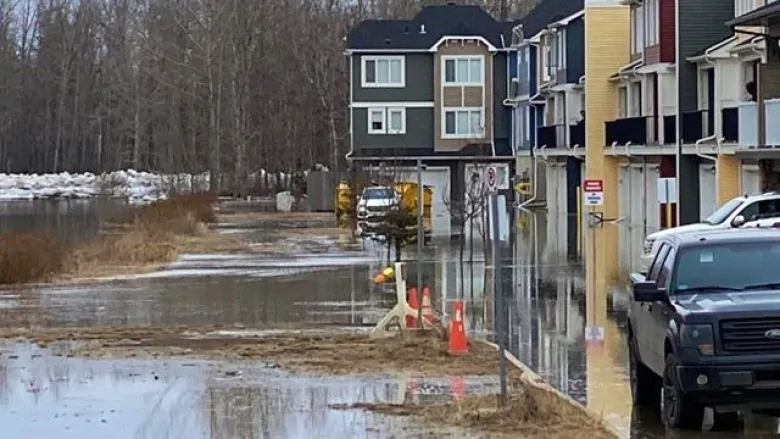Rising water prompts state of local emergency and mandatory evacuations in Wood Buffalo

Mandatory evacuations and a secondary state of local emergency were declared in Wood Buffalo on Sunday after rising water levels created a high risk of flash flooding.
The Regional Municipality of Wood Buffalo in northern Alberta declared a secondary State of Local Emergency because of high water levels along the Athabasca, Snye and Clearwater Rivers. The emergency applies to all of Fort McMurray, Draper, and the lower townsite and Clearwater areas in their municipality.
Wood Buffalo also issued mandatory evacuation notices Sunday morning for Draper, an unincorporated community of around 187 people around 12 km south of Fort McMurray, as well as the entire Taiga Nova Eco-Industrial Park. Longboat Landing in Fort McMurray also received notice later that afternoon.
At 6 p.m. Sunday, a voluntary evacuation order became mandatory for the Waterways area of Fort McMurray, including the Ptarmigan Trailer Park.
The notices directed residents to the Oil Sands Discovery Centre in Fort McMurray for more information on accommodations and support available to them.
Keyano College is evacuating the Clearwater Hall and Penherwood residences to the Microtel Hotel as a precaution, according to an update posted on its website Sunday. The evacuation is voluntary for the Riedel Housing college residence.
Mayor says municipality prepared
This is a secondary state of local emergency following the state of emergency already declared in the region because of the COVID-19 pandemic. Wood Buffalo Mayor Don Scott said emergency officials were well-prepared given the seasonal risk of flash floods.
“It’s a stressful time as it is with the COVID challenge upon us,” Scott said. “But we’ve been preparing for this potential ice jam with the knowledge that the COVID restrictions were in place, so it’s something we had well in hand.”
The evacuations came after the municipality warned communities on Saturday that Draper, as well as the Lower Townsite and Waterways areas in Wood Buffalo, were at a high risk for flash flooding. This comes as ice in the Athabasca River is currently breaking, raising water to extremely high levels.
The municipality also said residents in Waterways and the Lower Townsite should prepare a 72-hour emergency kit, as the risk of flooding for downtown, Waterways and Draper remains high.
An ice jam, impeding the river’s flow, forced water to move in the opposite direction and eventually caused water levels to rise. Scott said Fort McMurray faced similar floods because of ice jams in 1997 and 1977.
Scott said evacuees so far have been calm and diligent while looking out for one another.
“I’ve always said if any region knows how to respond to an emergency it’s us,” Scott said. “Because we’ve obviously experienced a few over the years.”
The rising water levels won’t affect the region’s water supply or threaten the integrity of bridges in the region, he said.
The municipality asked the public to keep away from the banks of the Athabasca River. Flooding is occurring along Clearwater Drive on Sunday, the municipality said. It advised people to avoid the area and to not travel along the road or in downtown Fort McMurray, if possible.
Evacuees should still follow physical distancing and current health guidelines while evacuating.
River flowing backwards
This is the second time in four years that Brenda MacLean has had to evacuate from her home in Fort McMurray. In 2016, she had to pack her things and flee when the Horse River Wildfire ripped through the community.
MacLean said she has never seen the river flood to this extent in the 19 years she has lived in Fort McMurray.
“I heard some loud noises this morning… and the river was going backward,” said MacLean in an interview on Sunday.
“It was quite alarming to see that.”
She lives right next to the river, and the water encroached on the bike path right outside of her building.
“It’s a lot to comprehend right now,” said MacLean.
Figuring out where to go
Kellie Young, a Fort McMurray resident for more than three years, was awoken by her husband telling her they may need to evacuate Sunday morning. Even before hearing from the municipality, they could see ice flowing backwards and water rising from their condo.
Young said she and her husband may leave their home even before getting official evacuation orders from the municipality if the water hits the road in front of their building.
She said she wasn’t surprised by the ice jam after recent days with cold temperatures thickened the ice, making it more of a threat to jam the river’s flow once it breaks. The problem she faces now is figuring out where to go.
“You’re supposed to keep yourself distanced, that’s the worst problem that we have,” Young said. “We have a daughter-in-law in Whitecourt, but then we’re supposed to keep social distancing from family.”
But once they saw the ice flowing backwards down the river, Young and her husband packed their suitcases immediately and took their cars out of the underground garage, ready to leave at a moment’s notice.
“I’m a ‘take it as it is’ kind of person. Deal with the situation and be prepared,” Young said.
“So I’m not one to panic. I find if you panic then things just go wrong.”
